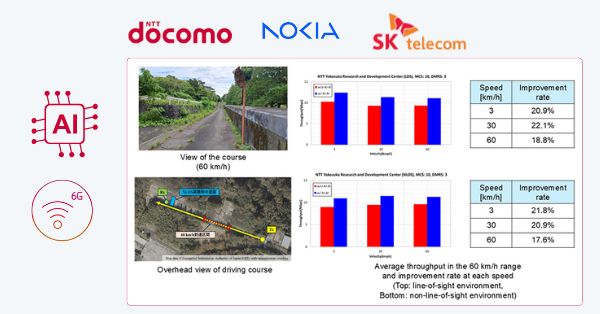AI-AI Air Interface: Why This 6G Field Trial Matters
A consortium led by NTT DOCOMO, NTT, Nokia Bell Labs, and SK Telecom has shown that applying AI to both transmitter and receiver—“AI-AI”—can materially lift outdoor 6G performance, pointing to an AI-native air interface that adapts in real time to messy, real-world radio conditions.
Outdoor AI-AI doubled peak 6G throughput in challenging radio conditions
In Yokosuka, Japan, the partners ran real-time field tests using a software-defined radio platform with GPU-based baseband to compare AI-driven versus conventional signal processing. Using 5G New Radio as the baseline at 4.8 GHz, the AI-AI approach improved average throughput by roughly 18% across mixed environments and delivered up to a 100% gain in the most challenging sections of a curved public road. A second course with partial obstructions also saw steady gains, while tests at speeds up to 60 km/h across both LOS and NLOS conditions achieved up to a 20% improvement. The net: AI at both ends consistently compensated for channel fluctuations outdoors, not just in controlled labs.
Who’s involved and why it matters
DOCOMO and NTT co-led implementation and trials, with Nokia Bell Labs and SK Telecom contributing research and operator perspective. This cross-operator, cross-vendor lineup matters: 6G’s AI-native PHY will only scale if large carriers and top-tier research labs align on how to train, deploy, and measure AI models in the air interface.
What AI-AI means for the 6G air interface
AI-AI places learning models on both transmitter and receiver to co-optimize modulation, coding, and demodulation decisions end-to-end based on instantaneous radio conditions.
From AI receivers to joint transmitter–receiver intelligence
AI in wireless started on the receiver side—channel estimation, equalization, and decoding. AI-AI goes further: the transmitter learns to shape symbols and adapt waveforms, while the receiver learns to interpret those choices under dynamic multipath, Doppler, and blockage. The feedback loop enables agile, context-aware PHY behavior that classical algorithms struggle to match when environments change rapidly.
Trial setup and methodology
The team used SDR hardware with GPU baseband processing to run real-time AI models, with the transmit antenna on a vehicle and receive antennas installed on a rooftop or a pole about two meters high. Courses ranged from gently curved roads with foliage and buildings to partially obstructed paths, with speeds from walking pace to 60 km/h and both LOS and NLOS paths. The comparison was straightforward: identical conditions, with and without AI-AI enabled, measured against a 5G NR reference.
Strategic implications for operators and vendors
The results suggest AI-native PHY can unlock spectrum efficiency, service consistency, and power savings—but only if compute, silicon, and standards line up.
Spectrum efficiency and QoE gains
Throughput lifts of 18–20% on average, and up to 2x in tough spots, translate to better cell-edge performance, steadier uplink, and fewer stalls for bandwidth-hungry and latency-sensitive applications. For operators, that means tangible spectrum productivity gains without new licenses, and for enterprises, more predictable SLAs in variable outdoor and campus scenarios.
Compute, energy, and silicon roadmap
Running learning models in the PHY layer stresses baseband compute and energy budgets. Today’s GPU-based proofs of concept will need to migrate to efficient accelerators in distributed and centralized RAN topologies—think programmable DSPs, NPUs, or AI-optimized ASICs in radios and DU/CU platforms. Power-aware model design, quantization, and sparsity will be as critical as RF design, especially for massive-MIMO and higher-frequency bands.
Standardization and interoperability roadmap
To scale, AI-AI needs a place in the 6G standards stack. Expect alignment with the ITU-R IMT-2030 vision and emerging 3GPP 6G studies on AI-native air interfaces. Key questions include how to specify model behavior versus weights, negotiate capabilities over the air, manage updates and fallbacks, and test conformance. O-RAN’s work on ML lifecycle and RIC-based control offers useful constructs, but AI in the PHY cuts below RIC timescales and demands new test vectors, KPIs, and certification methods.
What to watch next
The next phase will test scalability, robustness, and deployment models across harsher environments and tighter RAN constraints.
Mobility, bands, and antenna considerations
DOCOMO plans to extend trials beyond 100 km/h. The community should also probe performance at mid-band and mmWave/sub-THz, under wideband channels, beamformed massive-MIMO, and dense urban clutter. Robustness across rain fade, seasonal foliage, and interference scenarios will make or break production viability.
Deployment models and MLOps toolchains
Where do models run—in the radio, DU, or centralized cloud—and how are they trained and updated safely? Operators will need PHY-focused MLOps: dataset pipelines from live networks, domain adaptation for local conditions, shadow-mode validation, and rollback. Vendors should expose clear APIs for model insertion, telemetry, and hardware acceleration, without fragmenting interoperability.
Security, safety, and governance for AI-native PHY
AI-driven PHY must be resilient to model drift, adversarial perturbations, and malformed control signaling. Expect requirements for model provenance, signed updates, runtime attestation, and explainable KPIs that regulators and enterprise buyers can audit. Safety rails and deterministic fallbacks to conventional algorithms are essential.
Takeaways for technology leaders
AI-native wireless is moving from lab to road, and early movers can shape the efficiency and cost curves of 6G-era networks.
Near-term actions for 6G AI-AI pilots
Evaluate AI-AI in controlled outdoor pilots that mirror your priority use cases—mobility, LOS/NLOS mixes, and target bands. Engage vendors on silicon roadmaps for PHY-level AI acceleration and energy efficiency. Begin building datasets and validation harnesses that reflect your markets’ propagation realities. Track 6G standardization for how AI models will be specified, exchanged, and certified, and align internal governance so model updates meet security, compliance, and SLA constraints.
The Yokosuka results from DOCOMO, NTT, Nokia Bell Labs, and SK Telecom signal a credible path to AI-native 6G. The performance gains are real; the next test is turning them into deployable, interoperable, and power-efficient products at scale.









































